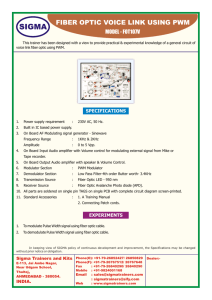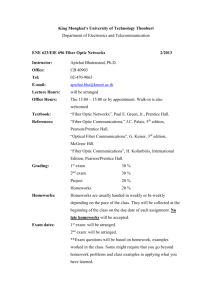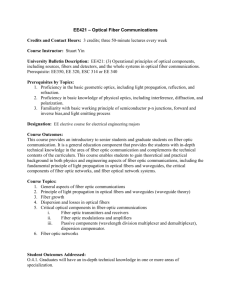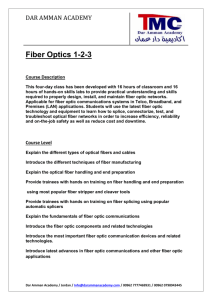File
advertisement
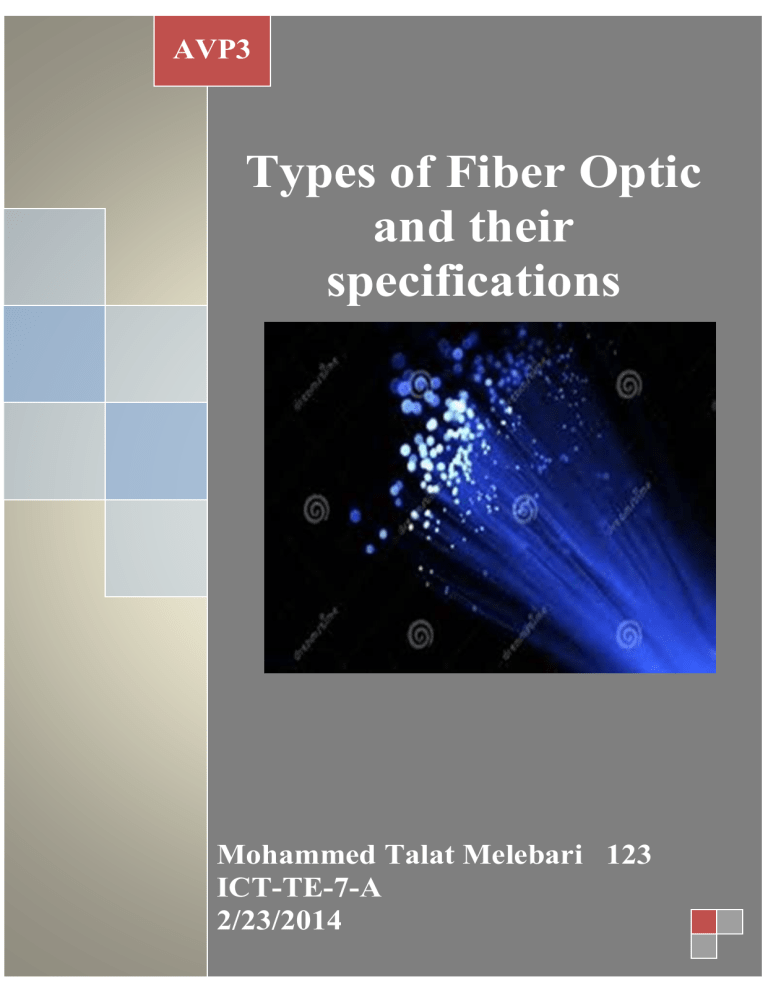
AVP3 Types of Fiber Optic and their specifications Mohammed Talat Melebari 123 ICT-TE-7-A 2/23/2014 AVP3 TRTS 23/02/2014 Department Topic ICT-TE-7 Types of Fiber Optic and their specifications Name\ID Mohammed Talat Melebari 123 Contents: Learning Conditions: .................................................................1 1 1.1 Trainees: .........................................................................................1 1.2 College: ..........................................................................................1 1.3 Classroom: ......................................................................................2 Didactic reflection: ....................................................................3 2 2.1 CURRICULUM ANALYSIS: ..........................................................3 2.2 CONTENT ANALYSIS: .................................................................4 2.2.1 What is Fiber Optic?................................4 2.2.2 Fiber Optic communication system: ..........4 2.2.3 Structure of Fiber Optic: ..........................4 2.2.4 How is Fiber Optic work? .........................4 2.2.5 Advantages and disadvantages of F.O: ......5 2.2.6 Application of Fiber Optic: .......................5 2.2.7 Types of Fiber Optic: ...............................5 2.3 DIDACTIC ANALYSIS : .......................................................................6 Lesson plan: .............................................................................8 3 3.1 GENERAL INFORMATION : .................................................................8 3.2 OBJECTIVES : ...................................................................................8 3.3 OVERVIEW OF THE INTENDED PROCESS (50 MINUTES) .....................9 4 Application of didactic principles: ............................................. 12 5 References: ............................................................................. 12 AVP3 TRTS 23/02/2014 1 Learning Conditions: 1.1 Trainees: NO Name ID Age 1 Mohammed .M Khaled Ahmed Badr Rame Mohammed Nasser 100 101 102 103 104 105 106 2 3 4 5 6 7 24 Former School CTI/Riyadh Home City Riyadh Last Certificate Diploma Last Grading A 30 22 21 23 24 21 CTI/Jeddah CTI/Riyadh CTI/Riyadh COT/ABHA CTI/Riyadh CTI/Jeddah Riyadh Dammam Riyadh ABHA Riyadh Jeddah Diploma Diploma Diploma Diploma Diploma Diploma B+ C D+ B+ A+ D They are 7 trainees in the class and each student has at least the general certificate of secondary education in the Telecommunications. The learning level of the trainees has major different. Performances are Fars and Mohammed. They participate very actively in class .Their contribution to teaching are good to very good. The work order and homework get quickly accepted. Also the presentation of results should be assessed positively. And I took the trainees grades in English tested and found that the average grades ranging from 10.6 to 15 from 15 degrees. And I can see that in the right of average score of trainees in general very good. All trainees are together along well and very good trainees are helpful and support with their trainees. And I will make discussion with them about everything. 1.2 College: I have a theory lesson, and I have Power Point I will use it in the presentation of the lesson to make the lesson interesting. That can help me to transfer the knowledge to the trainees, and I will show them pictures and video to make easy deliver the information. And I will use a white board and flipchart to draw and write some and answer, also I give to trainees handout has specific information about Fiber Optic. 1|Page AVP3 TRTS 23/02/2014 1.3 Classroom: I will use 8.243 classrooms in the VP building and the lesson will be at 7:30 AM. This time it is bitter for this lesson because this lesson more theoretical and at 7:30 the trainees can understand easily than afternoon because in the afternoon. In this class I should motivate the trainees by asking questions and do group work because if I motivate the trainees they will be more active and understand the lesson. I should ask the trainees about everything it is clear. Also I organized everything before my lesson. 2|Page AVP3 TRTS 23/02/2014 2 Didactic reflection: 2.1 CURRICULUM ANALYSIS: Course title: Transmission Lines and Optic Fiber. Course code: COM 240 Contact hours: L: 4 Hours, W: 2 Hours, T: Course description: This course covers the principle of operation and types of transmission lines and optical fibers and their technical specifications. Also covered are methods of connecting optical fibers, transmission characteristics of optical fibers, light sources and photo detectors. Prerequisites course: Basics of Communications (COM 136) Description of the General objectives: This course aims to give trainees the basic knowledge in the field of optical fibers, transmission characteristics and to participate in the design of optical fiber communication systems. Specific course objectives: At the end of this course, the trainees will be able to: Understand the principle of operation of optical fibers and their types. Be familiar with classification of optical fibers. Understand the transmission characteristics of optical fibers. Be familiar with fiber optic cables, construction, types and characteristics. Unit: Types of Fiber Optic cables and their specifications. One specific course objective related to the lesson is ( optic cables types and specifications.). 3|Page Determine fiber AVP3 TRTS 23/02/2014 2.2 CONTENT ANALYSIS: Actually this lesson is the first lesson in this subject so, does not have a previously lesson. 2.2.1 What is Fiber Optic? A fiber optic fiber is made of pure glass, and it is a long and thin and slightly thicker than a human hair. Combines many these fibers in bundles within the optic cables, used in optical signal transmission for very long distances. 2.2.2Fiber Optic communication system: The major components of an Optical Fiber communication system are: Optical source: Helps the electrical input signal to be modulated by a light wave carrier (electrical-optical conversion). E.g. Light emitting diodes (LEDs), laser diodes (LDs). Transmission medium: An optical fiber which provides the transmission of optical wave from the transmitter to the receiver. Optical detector: Provides demodulation of the optical carrier (optical- electrical conversion).e.g.: Photodiodes, phototransistors and photoconductors. 2.2.3Structure of Fiber Optic: Core: thin glass center of the fiber where light travels. Cladding: outer optical material surrounding the core. Buffer Coating: plastic coating that protects the fiber. 2.2.4 How is Fiber Optic work? An optical fiber is a long, thin strand of clear material. Its shape is usually similar to a cylinder. In the center, it has a core. Around the core is a layer called the cladding? The core and cladding are made of different kinds of glass or plastic, so that light travels slower in the core than it does in the cladding. If the light in the core hits the edge of the cladding at a shallow angle, it bounces off. Light can travel inside the core and bounce off of the cladding. No light escapes until it comes to the end of the fiber, unless the fiber is bent sharply or stretched. If the cladding of 4|Page AVP3 TRTS 23/02/2014 the fiber is scratched, it may break. A plastic coating called the buffer covers the cladding to protect it. Often, the buffered fiber is put inside an even tougher layer, called the jacket. This makes it easy to use the fiber without breaking it. 2.2.5 Advantages and disadvantages of Fiber Optic: Advantages: Smaller in size and weight. Electrical isolation. Increased signal security. Low transmission loss. Larger information carrying capacity. Disadvantages: Expensive over short distance. Requires highly skilled installers. Adding additional nodes is difficult. 2.2.6Application of Fiber Optic: Long distance Telecommunications Local Telephone Networks Local Area Networks Internet and data communications Cable TV Military Communications 2.2.7Types of Fiber Optic: Basic types of fiber cables structures are available: 1. Tight buffered fiber cable. 2. Ribbon Fiber Cable. 3. Loose tube cable. 1. Tight buffered fiber cable: Each fiber is individually encapsulated in 900 µm diameter plastic buffer structure. Enables direct plugging with connectors. 5|Page AVP3 TRTS 23/02/2014 This resists for moisture and temperature effects. Used for indoor applications. 2. Ribbon Fiber Cable: Fibers are aligned very tightly each other than are encapsulated in a plastic buffer. A ribbon typically has from 4 to 12 fibers. Used in facilitating filed operations of splicing cables. 3. Loose Tube Fiber Cable: One or more fibers are enclosed thermoplastic tubes. This tube is filled by a dry water blocking gel which facilitates the fibers to be moved freely and prevents moisture entering to the tube. Optional copper wires are used to power inline equipment. Used in outdoor long-haul communication applications. After I finish my lesson the trainees have their knowledge to understand the next lesson.it is about the Transmission Characteristics of Optical Fibers. It has two types loss the signal of fiber optic the first is Attenuation and another is Dispersion. 2.3 DIDACTIC ANALYSIS: In this lesson I use different methods. First of all, I will do story for the trainees about my problem. That method makes the trainers fully attention and motivates them to understand. Next I will explain for the trainees what is the Fiber Optic, structure of Fiber Optic and the types of it. Show the steps of the lesson clearly and organize. I use whiteboard and flipchart to make the trainees write own solve and the other trainees see the answer. Third, I will show the trainees video about how 6|Page AVP3 TRTS 23/02/2014 it work and also do group work to make them more active. In Addison I will make group work to research and find about advantages and disadvantages of fiber optic and write on flipchart. This method make every trainees think and get self-responsibility after that all the class share the result this help to get action-from and social-from .Finally, I will give the trainees handout to document the topic, and help the trainees to remember the topic. 7|Page AVP3 TRTS 23/02/2014 3 Lesson plan: 3.1 GENERAL INFORMATION: Topic: Types of Fiber Optic and their specifications. Name: Mohammed Talat Melebari (123) Date: 23/02/2014 3.2 OBJECTIVES: A. General Objectives: The Trainees are able to…… Work together in group work. (affective) Create a nice and efficient work atmosphere. (affective) Make an active class. (affective) B. Specific Objectives: The Trainees are able to…… Describe Fiber Optic briefly. (cognitive, reorganization) Draw the communication system of Optical Fiber. (cognitive, Reproduction) Describe the Optical Fiber structure. (cognitive, reorganization) Analyze how Fiber Optic works. (cognitive, transfer) List the advantage of Fiber Optic. (cognitive, reorganization) List types of Fiber Optic. (cognitive, reproduction) 8|Page AVP3 TRTS 23/02/2014 3.3 OVERVIEW OF THE INTENDED PROCESS (50 MINUTES) Opening / Entrance / Motivation Expected Traineraction The trainer will introduce the lesson by greeting the trainees. The trainer will take the attendance. Expected Traineeaction Time Methodology Minutes The trainees will great bake the trainer. Introduction The trainees will say present. Power point -The trainee will focus in questions and how to solve it. Media The trainers will The trainees will start the lesson focus on the story and with a story try to interact with the trainers. Slide number 1 story Classroom conversation Body (Information / Elaboration) Expected Trainer-action 9|Page Expected Traineeaction 6 min Time Methodology Media Minutes AVP3 The trainer will tell to trainees what are his objectives? The trainer will explain what is Fiber Optic The trainer will ask one of trainees to draw Fiber Optic communication system on whiteboard. TRTS 23/02/2014 Power Point Slide number 2 The trainees will keep attention with the trainer. 5 min lecture Power Point Slide number 3 One of trainees will draw F.O communication system and the other will take notes on the worksheet. Power Point Classroom Slide number 4 conversation whiteboard 5 min The trainer will ask the trainees what is the structure of Fiber Optic? The trainees try to answer the question and write notes on the worksheet. The trainer will do an experiment about how is F.O work. The trainees try to understand the idea. Power Point Classroom conversation Slide number 5 Power Point Slide number 6 Experiment 9 min The trainer will show the trainees small video about how is 10 | P a g e The trainees will be focus on and write notes Video AVP3 TRTS F.O work 23/02/2014 on the worksheet. The trainer will ask the trainees what is Advantages and Disadvantage of Fiber Optic? The trainees Search on the internet to answer the question and share their knowledge. Group work The trainer will ask the trainees about what is application of Fiber Optic? The trainees try to answer the question and take notes on the worksheet. Classroom conversation I pad 10 min Flipchart Whit board Power Point Slide number 8 10 min The trainer will explain about types of Fiber Optic to the trainees? The trainees try to answer the question and be attention. Close (Reflection, Exercises, Homework, Feedback) Expected Traineraction The trainers do a quick review with the trainees and expect any questions. 11 | P a g e Lecture Slide number 9,10,11,12 Methodology Time Media Minutes Expected Trainee-action The trainees ask questions if they have. Power Point Classroom conversation 5 AVP3 TRTS 23/02/2014 4 Application of didactic principles: Didactic Principles of motivation by doing a story and discussions at the beginning of the lesson. Didactic Principles of reduction by using vertical reduction. Didactic Principles of methodological change by using social and action form. Didactic Principles of vividness by using pictures, color and video. Didactic Principles of self-activity by doing group work. Didactic Principles of securing the learning progress by deliver the work sheet at the end of the lesson. 5 References: Transmission Lines and Optic Fiber, Publisher is The Technical and Vocational Training Corporation; viewed 17/02/2014. Fiber-optic communication. Retrieved from wikipedia: http://en.wikipedia.org/wiki/Fiber-optic_communication ; visited 17/02/2014. Optical Fiber Communications, Publisher is The Technical Trainers College; viewed 17/02/2014. Fiber optic cables: How they work, Retrieved from YouTube: http://www.youtube.com/watch?v=0MwMkBET_5I;visited 17/02/2014. 12 | P a g e


